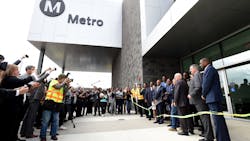L.A. Metro celebrates completion of the Southwestern Yard
The Los Angeles County Metropolitan Transportation Authority (L.A. Metro) held a ribbon cutting ceremony to celebrate the completion of Southwestern Yard, which will serve the future Crenshaw/LAX Line and Metro Green Line.
The $172-million facility was designed and constructed to attain LEED Silver Certification. The "green" features include pollution reducing construction processes, easy access to public transportation for workers, treatment of stormwater runoff and the use of low-emitting paints, sealants, coatings and materials. There is also energy-saving lighting and air conditioning.
“This cutting-edge facility is a great example of Metro’s commitment as an international leader in environmental and sustainable practices. Metro is supporting progressive programs and minimizing the kind of environmental impacts that can result from the planning, construction and operation of one of the largest and fastest growing transportation systems in the country,” said L.A. County Supervisor and Metro Board Chair Sheila Kuehl. “With all the green features incorporated into the Southwestern Yard, we continue to move in the right direction.”
Hensel Phelps Herzog (HPH) designed and built Southwestern Yard with design work beginning in June 2015, construction in May 2016 and work completed in January 2019 with the project on time and on budget.
L.A. Metro explained that its Southwestern Yard, the Airport Metro Connector/96th Street Station, the Automated People Mover and the Aviation/Century Station will become the gateway to LAX for travelers and will provide better and equitable access to employment centers in this area.
“We are well on our way to connecting our public transit system to one of the world’s busiest airports,” said L.A. County Supervisor and Metro Board Member Mark Ridley-Thomas. “This gleaming new rail yard is part of the effort to get the Crenshaw/LAX Line up and running, and offering passengers a convenient, not to mention state-of-the-art, way to reach the airport.”
Light-rail vehicles will be maintained and inspected at the 115,000-square-foot facility where other work will be done including body repairs, painting, storage and cleaning and washing. In addition, the facility will house general administration and support service staff, miscellaneous maintenance shops and equipment housing and storage. The rail yard will have the capacity to store 70 light-rail vehicles and will have about 200 employees.
“The Southwestern Yard facility is a much-needed asset for Metro’s rail operations team and will be used to bring quality and reliable service to this region using advanced technologies,” said L.A. Metro CEO Phillip A. Washington. “Both the Crenshaw/LAX and Green lines will benefit from this facility, which will also help Metro deliver great service and an enhanced customer experience.”
The Southwestern Yard is part of the Crenshaw/LAX Transit Project, the 8.5-mile light-rail line that will meet with the Expo Line and connect with the Green Line near the Aviation/LAX Station. In 2020, L.A. Metro is expected to begin major construction on the Airport Metro Connector/96th Street Transit Station, which will be next to the new rail yard. The station will be the transfer point between local transit — including the Crenshaw/LAX Line and Green Line — and Los Angeles International Airport’s future Automated People Mover. The station and people mover are forecast to be complete in 2023.
About the Author

Mischa Wanek-Libman
Group Editorial Director
Mischa Wanek-Libman is director of communications with Transdev North America. She has more than 20 years of experience working in the transportation industry covering construction projects, engineering challenges, transit and rail operations and best practices.
Wanek-Libman has held top editorial positions at freight rail and public transportation business-to-business publications including as editor-in-chief and editorial director of Mass Transit from 2018-2024. She has been recognized for editorial excellence through her individual work, as well as for collaborative content.
She is an active member of the American Public Transportation Association's Marketing and Communications Committee and served 14 years as a Board Observer on the National Railroad Construction and Maintenance Association (NRC) Board of Directors.
She is a graduate of Drake University in Des Moines, Iowa, where she earned a Bachelor of Arts degree in Journalism and Mass Communication.
